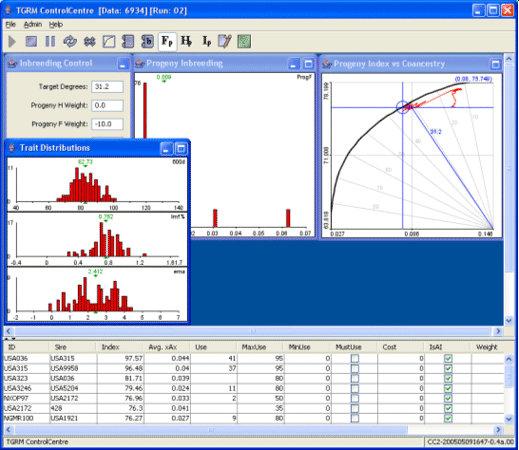 TGRM™ In More Detail
TGRM™ In More Detail
TGRM™ is used with the data from your breeding animals. You nominate the sires and dams that are available, or may become available, for selection as parents. Working together with your TGRM service provider, you set your goals and constraints.
The graphical user interface provides rich feedback and interaction on the tradeoff between genetic progress and coancestry, traits, inbreeding, sires and QTL or major genes.

TGRM Reports
In addition to the graphics, the TGRM software provides comprehensive reporting:
- a summary report of predicted breeding outcome, including estimates of progeny index, coancestry, progeny inbreeding, and trait means,
- sire usage report , including sire contributions to progeny inbreeding and coancestry, and
- the mating list report with predicted progeny outcomes for inbreeding, mid-parent index and mid-parent estimated breeding values.
These reports help you make decisions about:
- sire use and semen purchase,
- stock selections and mating allocation,
- donor identification, oocyte and embryo collection,
- and use of DNA marker information.
The ability to compare reports allows "what-if" analyses and comparison of different strategies, sire lists and resource constraints.
TGRM™ has been successfully used in the following species and industries:
- beef cattle,
- meat sheep,
- wool sheep,
- dairy,
- pigs,
- rabbits,
- poultry breeding systems, and
- conservation genetics programs.
The flexibility of TGRM has allowed its application across a range of uses in addition to the core feature of maximisation of genetic progress and control over coancestry and inbreeding.
Applications to date have involved:
- maintenance of genetic diversity,
- minimisation of inbreeding,
- crossbreeding and increasing heterosis,
- artificial insemination (AI),
- embryo transfer (MOET),
- In Vitro Fertilisation (JIVET),
- use of DNA markers,
- targeting multiple market end-points,
- animal migration, and
- maximisation of enterprise profit.


